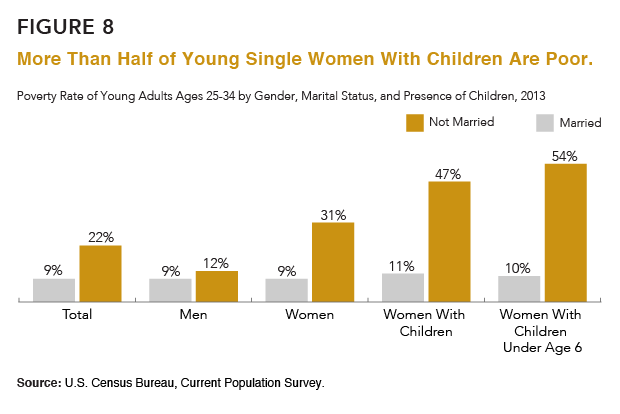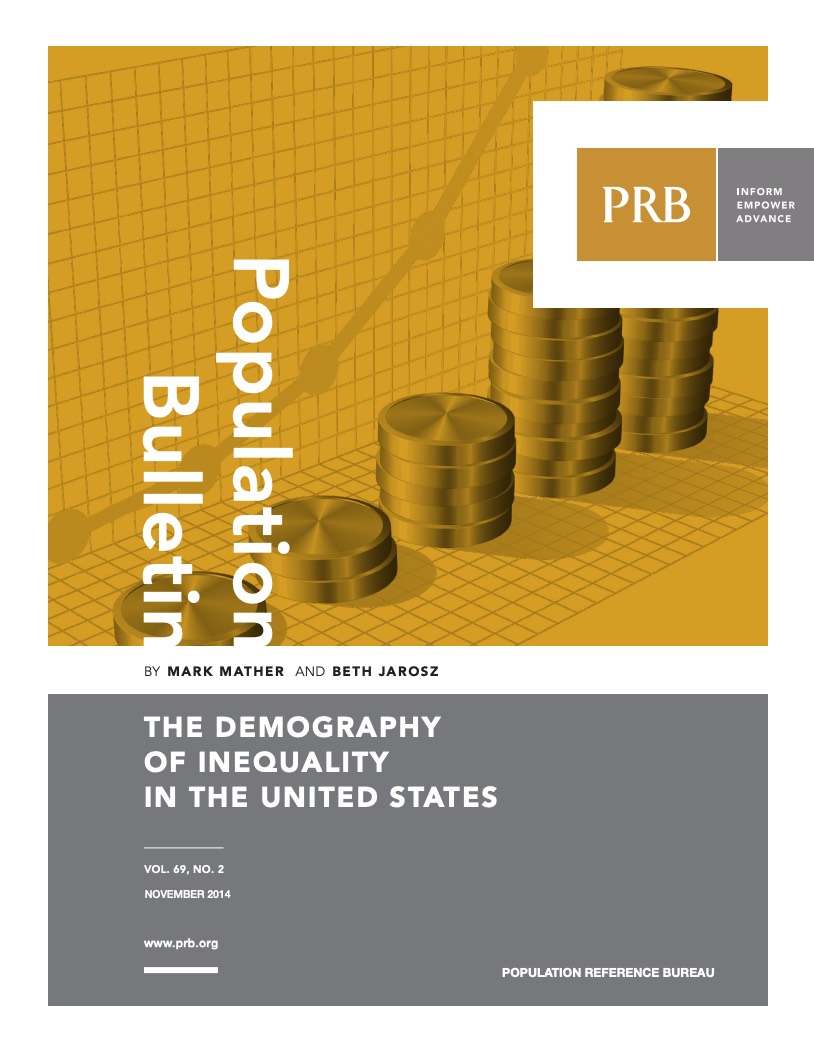
Women Making Progress in U.S., But Gaps Remain
Product: Population Bulletin, vol. 69, no. 2: The Demography of Inequality in the United States
Authors: Mark Mather Beth Jarosz
Date: November 17, 2014
The rise in female labor force participation has transformed gender relations, changed patterns of marriage and childbearing, and is often viewed as a key indicator of women’s progress toward gender equality at home and in the workforce. Since 1970, women’s labor force participation rate has increased from 43 percent to 57 percent, while the proportion of men in the labor force declined from 80 percent to 70 percent.26 Women’s participation in the labor force has declined slightly in recent years—in part because of population aging— but the gender gap continues to shrink as more women enter the labor force relative to men.
However, there is more to gender equality than closing the labor force gap. Among those working full-time and year-round, there is still a sizeable gap between the median earnings of men ($50,033) and women ($39,157). A higher proportion of women work in lower-paid service and retail jobs, but even for the same job, women earn significantly less than men. Women make up about 46 percent of those working full-time in management, business, and finance jobs but their median earnings in those positions are only about 74 percent of men’s earnings.27 Women are also underrepresented in high-paying jobs in the natural and physical sciences, mathematics, and engineering. Women currently account for nearly half of the total U.S. labor force but only about one-fourth of scientists and engineers.
A woman’s risk of living in poverty is closely linked to her marital and family status (see Figure 8). In 2013, about 31 percent of young, unmarried women were poor, more than three times the poverty rate for young married women (9 percent). Among women with children, the poverty gap between married and single women is even larger. Over half (54 percent) of unmarried women with young children were poor in 2013—more than five times the rate for married women with young children (10 percent).

Many people assume that single mothers are poor because they are not working. But in fact, three-fourths of all single mothers are in the labor force, and single mothers have slightly higher labor force participation rates than women in married-couple families. However, not all of these single mothers in the labor force are currently employed; single mothers are more than twice as likely to be unemployed (12 percent) compared with mothers in married-couple families (5 percent); and the majority of employed single mothers—59 percent—are working in retail, service, and administrative jobs that typically provide low wages and few benefits.28
Changes in family structure have often been implicated in the overall increase in poverty and inequality in the United States during the past several decades. While the increase in single-parent households has accounted for much of the increase in child poverty in the 1970s and 1980s, changes in parents’ access to good jobs account for most of the increase in child poverty since 1993.29 The rise in single-mother families also contributed to the increase in income inequality during the past several decades, but this effect was largely offset by an increase in female labor force participation, especially among single mothers.30
The gender wage gap is closing, partly because of the increase in women’s education relative to men. The proportion of women ages 25 to 29 with at least a bachelor’s degree has exceeded that of young men since 1991.31 A growing share of married women earn more money than their husbands—now 38 percent, up from 24 percent in 1987.32 The gender wage gap could improve with further reductions in gender discrimination at work and policies to help parents balance work and family responsibilities.
Government safety nets have reduced the burden of poverty for millions of lower-income families. From 1975 to 2007, aid through programs such as Food Stamps, Medicaid, and the Earned Income Tax Credit increased by 74 percent. However, married couples, older Americans, and lower middle-class families benefited disproportionately from this increase, while average benefits declined for the poorest families, especially single mothers and their children.33
In recent years, the proportion of people who are married has remained fairly stable for college graduates, but has sharply declined among those without college degrees.34 Some have argued that marriage is becoming a luxury good, reserved for men and women with better economic prospects.35 This trend is significant because marriage is associated with many benefits for families and individuals, including higher income, better health, and longer life expectancy. People with higher potential earnings and better health may be “selected” into marriage, resulting in better outcomes for married couples; but most researchers agree that marriage also has an independent and positive effect on well-being.36
NEXT: Education: The Great Equalizer?
POPULATION BULLETIN CHAPTERS
Introduction
The Backdrop: Rising Inequality
Where Poverty and Inequality Intersect
The Generational Divide
Persistent Racial/Ethnic Gaps
Women Making Progress, But Gaps Remain
Education: The Great Equalizer?
Looking Ahead
References
- U.S. Bureau of Labor Statistics, “Labor Force Statistics From the Current Population Survey,” accessed at http://data.bls.gov/pdq/querytool.jsp?survey=ln, on Aug. 26, 2014.
- U.S. Bureau of Labor Statistics, “Median Weekly Earnings of Full-time Wage and Salary Workers by Detailed Occupation and Sex,” accessed at www.bls.gov/cps/cpsaat39.pdf, on Oct. 24, 2014.
- U.S. Bureau of Labor Statistics, “Table 5. Employment Status of the Population by Sex, Marital Status, and Presence and Age of Own Children Under 18, 2012-2013 Annual Averages,” accessed at www.bls.gov/news.release/famee.t05.htm, on Aug. 5, 2014; and PRB analysis of data from the U.S. Census Bureau, 2014 Current Population Survey.
- John Iceland, Poverty in America: A Handbook (Oakland, CA: University of California Press, 2003).
- Bruce Western, Deirdre Bloome, and Christine Percheski, “Inequality Among American Families With Children, 1975 to 2005,” American Sociological Review 73, no 6 (2008): 903-20.
- Kelvin Pollard, “The Gender Gap in College Enrollment and Graduation” (April 2011), accessed at www.prb.org/Publications/Articles/2011/gender-gap-in-education.aspx, on Aug. 5, 2014.
- U.S. Bureau of Labor Statistics, “Wives Who Earn More Than Their Husbands, 1987-2012,” accessed at www.bls.gov/cps/wives_earn_more.htm, on Aug. 5, 2014.
- Robert Moffitt, “The Deserving Poor, the Family, and the U.S. Welfare System,” Population Association of America Presidential Address, May 2, 2014.
- Mark Mather and Diana Lavery, “In U.S., Proportion Married at Lowest Recorded Levels” (September 2010), accessed at www.prb.org/Publications/Articles/2010/usmarriagedecline.aspx, on Oct. 17, 2014.
- Jason DeParle, “Two Classes, Divided by ‘I Do’,” New York Times, July 15, 2015.
- U.S. Department of Health and Human Services, Office of the Assistant Secretary for Planning and Evaluation, Office of Human Services Policy, “The Effects of Marriage on Health: A Synthesis of Recent Research Evidence,” accessed at http://aspe.hhs.gov/hsp/07/marriageonhealth/rb.htm, on Sept. 26, 2010.

 ">
">